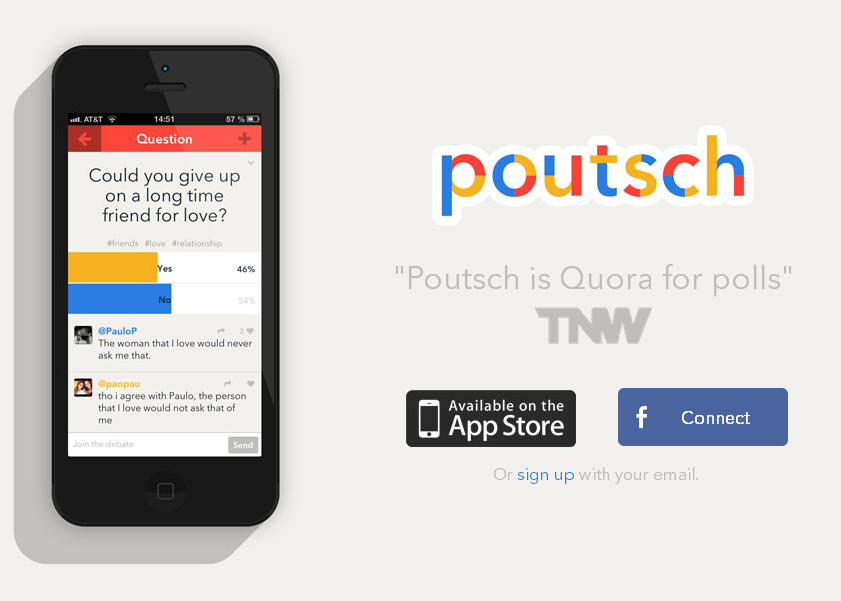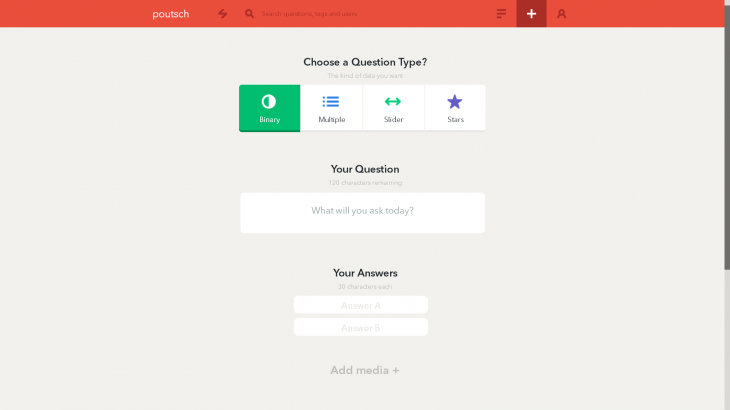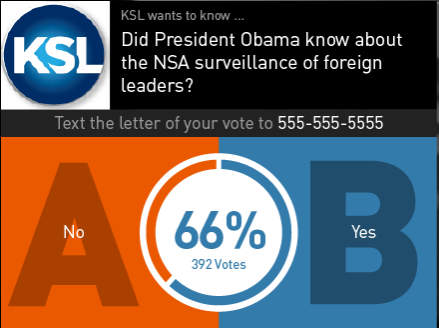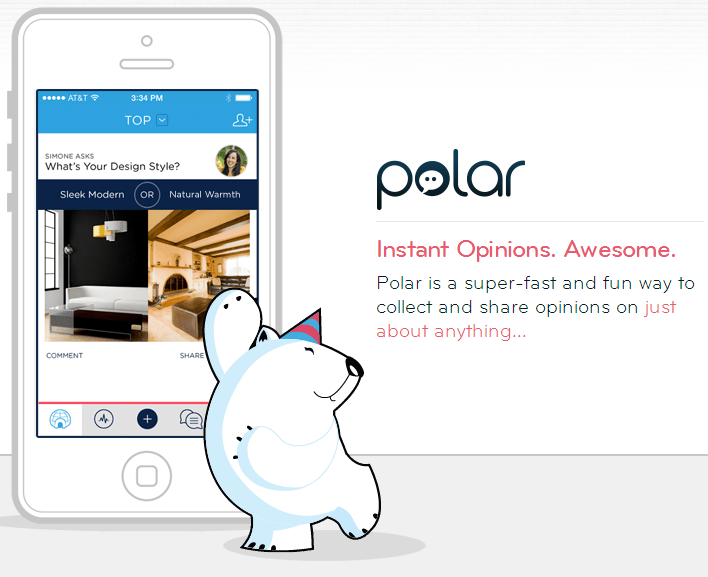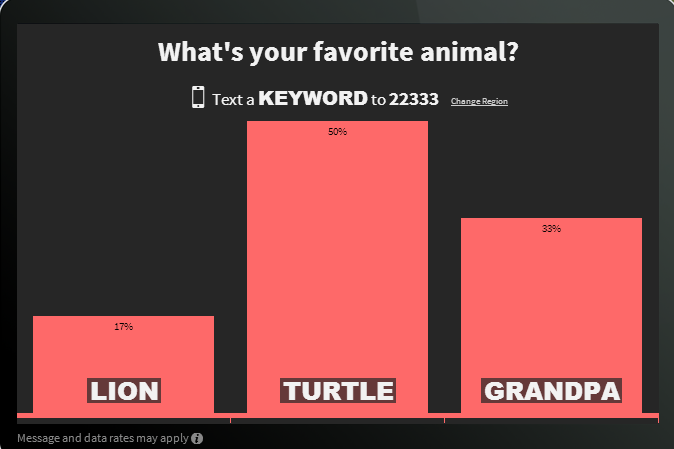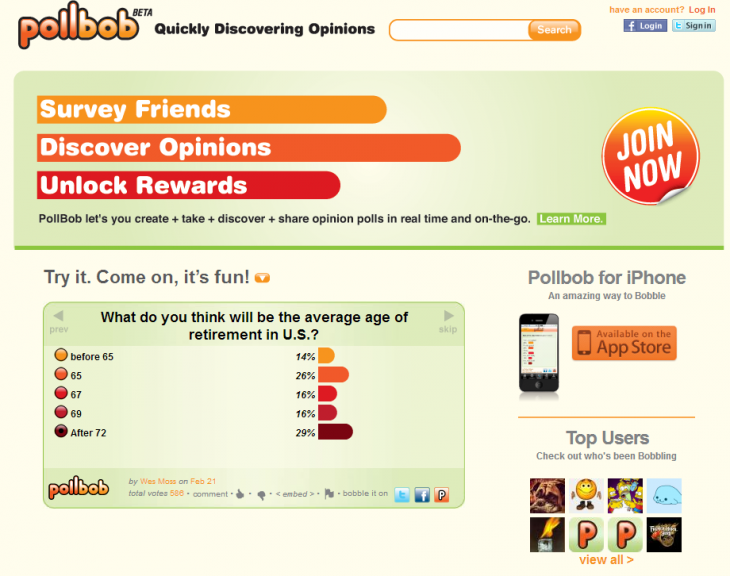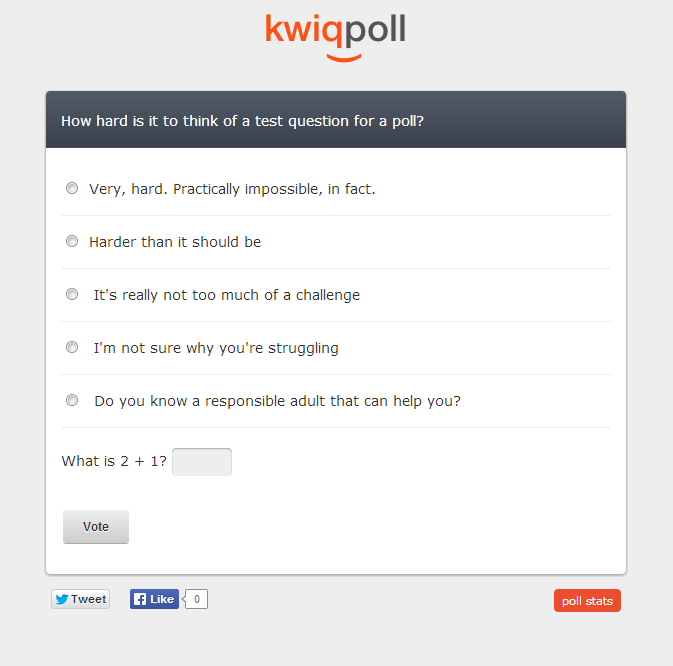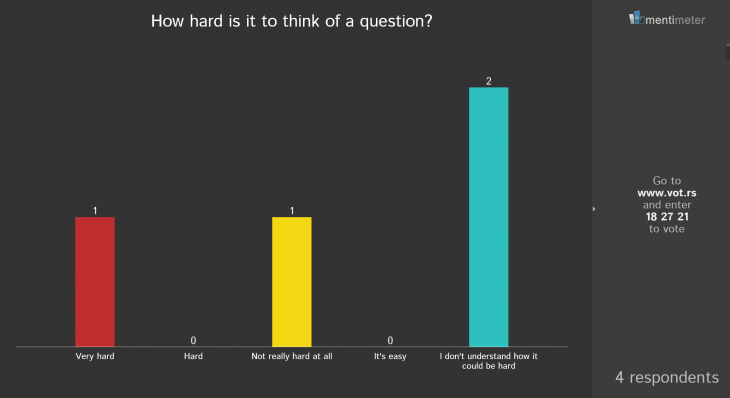
Creating surveys and opinion polls can be a real drag, so can filling them out. That’s why we only ever keep them short, sweet and to the point.
Over the years, we’ve come across numerous ways of getting the job done. What follows are just a few of our favorites – and we’ll tell you right now, none of them are quite perfect, but each has its own strengths. And we trawled through a lot of far less pretty or functional ones to bring you this list, some of which we’ve included at the end for one notable reason or another.
Poutsch
Poutsch is a French-Belgian startup now based in New York and unlike a lot of the other polling apps in this list, it also has elements of being a social network too.
While users can ask their questions and polls using the simple interface, Poutsch really wants to be a question and answer platform, a bit like Quora, but without there being one best answer.
Creating a poll is easy: users simply need to open a (free) account, select the type of question they’d like to pose, enter the details and select an image to go with it. That’s it.
What that means is that as well as offering a fully-capable simple polling platform, Poutsch also has an active social element to its quizzing. And social integration from the ground up often provides a better experience than tacking it on to an existing product.
Somewhat strangely, once users have voted in a Poutsch poll on the Web, they can also change their mind to a different answer once they’ve seen how everyone else responded.
While it offers a fully featured Web platform, it lacks truly detailed analytics that businesses and serious brands require. There’s also an iOS app too for garnering opinions on the move.
Ranker
Ranker is slightly different to others in this list, as rather than simply provide embeddable polls for other sites, it also acts as a browsable hub that invites users to make a list of their most or least favorite items. For example, you might get a question about who your favorite Doctor Who is played by, or you might find simply find a list like Vegetables I Won’t Eat – currently, it seems the radish is the most shunned of the veg world.
Users get the option to set lists for the public to vote on, or just to display so the order can’t be changed – hence why it’s a little different to some of the others featured in this roundup.
Who In Bill & Ted’s Universe Would Win At Poker?
As with many of the others here though, you get the choice to create your own, populating it with images and links to make it more entertaining and engaging. As the main point of the platform isn’t quite polling in the traditional sense, focusing rather more on the community as a whole. Looking at an embedded poll (like the one above) gives options to show as many or few rows as you like. Looking at the same poll on the Web displays more pros and cons for each entry, in this case, for each character and why they’d make the best poker player.
Unlike the other apps, you also don’t get the detailed metrics that might be handy to crafting future questions or polls, making it of less use for pro pollers.
Wedgies.com
And now we get to one of our favorites on the list: Wedgies.
It’s a little simpler than some of the others, but that may be no bad thing, and it does come with significant advantages too.
For example, as well as being able to set up an embeddable poll, like the one shown above, Wedgies also allows users to set polls specifically for sharing on social media and can even allow for responses via text message, shown below.
With plenty of ways to publish polls, engaging image and text layouts and some metrics thrown into the mix, it’s a great balance of simplicity, functionality and design. As an added bonus, the Wedgies team is more than willing to work with corporate customers to customize polls for their needs.
Social media polls can be created for free (up to five response options), while embeddable polls will set businesses back $50 per month and up. Text message polls are also priced from $50 per month.
Premium users also get access to deeper analytics including geography of voters, vote overlap between questions asked, voter information, more robust charting of responses, and exportable results.
PollDaddy
PollDaddy was referred to by The Next Web’s Community Director as “the king of polls”, before he quickly added “in that it’s widely used”.
Heritage in the space brings a certain level of maturity and refinement, but it also means it falls short in some areas.
As an industry leader, PollDaddy offers the usual kind of things you’d expect of a polling app, including the ability to embed, customize and add rich media to polls.
It’s also a part of the Automattic/WordPress family, meaning it works well with WordPress blogs, not that some of these others won’t too. PollDaddy polls can also be embedded in other websites, on Twitter and Facebook, and a host of other places.
There’s also an iOS app (shown below) too, so PollDaddy users can collect responses even when offline and sync them when connected again. Like on the desktop, it’s not the prettiest though.
On the plus side, it’s a very powerful tool with a feature set that could appeal to large enterprises, including security and advanced reporting tools, as well as some more ‘at a glance’ analytics options.
However, having heritage also has its downside – in this case, the design is pretty bland and it hasn’t yet been endowed with features that could truly take advantage of social elements, which would likely drive more people to respond.
Despite its minor faults though, PollDaddy still makes its way onto The Next Web from time to time – although we’ve mostly moved towards better looking options. It feels more suited to an employee survey than a quick poll.
Polar
Polar is one of the newer tools in this roundup and is a little more limited than some of the more established players. It does, however, have its own iPhone app. Being new has other advantages too — for one, it’s far easier on the eyes than a lot of others in this list.
Another advantage of being created post Web 2.0 is that Polar has social and sharing features baked into its DNA. This is helped along by being largely image-led as a polling tool – all you need to do is set your question, responses and an image and you can start sharing.
Handily for the people filling out the poll, collated responses are shown immediately. It’s always annoying when you bother to respond to an interesting poll question, only to have to jump through hoops to find out how everyone else voted too. That isn’t the case with Polar, once viewers have voted, they’re shown the overall responses.
However, as it stands right now, there’s on big drawback for businesses, brands or individuals wanting to use Polar – there’s no Web platform.
What this means is that polls can only be created using the iOS app, which can make it a more time consuming affair than it strictly needs to be. Naturally, there is a Polar website, but currently this can only be used to view or vote on polls, not create them.

This is a pretty big limitation, particularly for publishers such as us, but Polar plans to introduce a Web portal soon, so creating the polls should get a whole lot easier. It could also open the door to more detailed analytics too, as what it offers right now is a bit limited for serious business use and falls short of some others.
On the plus side, Polar does allow for a series of embedded polls, so when a user has responded to one, the next one in the series pops up. It also offers ‘custom actions’, so, for example, questions and their images can be linked to actions, like following a brand on Twitter or ‘Liking’ a Facebook page. Alternatively, they can be set up to link to any other Web page. Publishers could, for instance, set a question about what a visitor wants to view next, and in voting on their choice, they are then taken to that content.
➤ Polar.com | Apple Store
Poll Everywhere
Poll Everywhere’s offering definitely resides at the simpler end of the UI spectrum, but it’s aimed at live events primarily, rather than being purely based on the Web – although results are fed back in real-time.
A user simply signs up, decides what question they want to ask and then inputs the potential answers. Poll respondents then have a choice of ways to lodge their vote in the poll: via the Web, a mobile device, SMS or via Twitter.
The SMS voting option works by assigning a number to each possible response and having respondents simply text that code number to the phone number provided. Premium Poll Everywhere users (prices range from free to $1,400 per month) can set custom keywords for respondents to text rather than the code number. Other premium features include: moderation options (reviewing messages before they are put up on a big screen in front of an audience is probably a good idea), audience segmentation options (comparing or contrasting differences in responses to different questions based on gender, for example) and a host of other in-depth features, not to mention the ability to poll bigger audiences.
Responses can be tracked live on the Web, or even in a PowerPoint or Keynote presentation using the company’s app.
Clearly not quite the same as the rest of the polling apps on this list, Poll Everywhere deserves a mention for its live event potential.
PollBob
PollBob is perhaps a less serious-looking polling tool than some of the other more enterprise-y options that have been included here, but it provides a quick way of garnering public opinion. One of the key differences between PollBob and most of the others is that it encourages community development and engagement through gamification, in this case, offering “rewards” for using the platform. Here, rewards means badges, coupons, and “secrets for accomplishing different tasks”.
There’s also an iOS app too, which is likely to increase the number of responses each question gets.
For businesses, PollBob provides Promoted Polls “for quick and inexpensive market research” and advanced user analytics.
Notable mentions
The five apps listed on the previous page are our go-to choices when putting a poll together. All of them, in some way, represent a different take on polls and offer support for distribution and creation through different platforms. That’s not to say there aren’t plenty of other options out there, though.
There are bare-bones options like Poll Code which offers registration-free, but really basic, polls for embedding on websites – and others like Micro Poll, which has a good feature set and options for sharing the poll directly to Facebook, but just looks a little dated.
AddPoll is an option that strikes a good balance between the tools provided and the pricing – particularly if you’re only interested in polls, rather than fully-fledged surveys. Included in the free package, users can get a custom domain and a custom branding design as well as unlimited poll responses. Premium options start from $15.95 per month (if you pay annually) and add a whole bunch more features too.
If all you need is a no-nonsense poll with a few answers, no images and some basic feedback in terms of metrics and responses, then KwiqPoll (shown above) really lives up to its name. In less than two minutes, we made this poll with no registration and no faffing. There’s no integration or embedding options though, so you’ll need to share the link.
If polls are only a small but important part of what you need in a bigger package, the ProProfs Polls Maker could be worth a look. It allows the use of pictures and other formatting customizations, and is backed up by a full reporting suite. Even better, basic polls are free to create, although you’ll need an account, or to sign in via a social network like Google+ or Facebook.
MapYourVote is another tool that’s worth a mention if you’re looking to primarily identify the opinions of a geographical area. By default, results for each poll are shown according to where the respondents were based. In order to create polls, you’ll need to create a MapYourVote account, but guest users are free to vote on and view results of polls on the site. Embedding polls also requires a full account.
Mentimeter is the last in our list, and is included for its platform agnostic, if somewhat awkward approach. Users can create a survey quickly and freely, but in order to garner responses, respondents need to visit Vot.rs and input the poll code before they can vote. It’s a bit clunky, but it’s a system that allows for easy voting from mobile devices and tablets too.
If we’ve missed your favorite off this list, let us know and we’ll take a look at it for potential inclusion.
Featured Image Credit – Getty Images
Disclosure: This article contains an affiliate link. While we only ever write about products we think deserve to be on the pages of our site, The Next Web may earn a small commission if you click through and buy the product in question.
Get the TNW newsletter
Get the most important tech news in your inbox each week.
